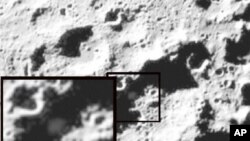Last October, a NASA rocket, traveling at a speed of 9,000 kilometers per hour, smashed into a dark crater on the moon's south pole.
Upon impact, the Centaur rocket kicked up a cloud of debris and elements from the moon's surface, creating a so-called "ejecta-plume" that was monitored by NASA's Lunar Reconnaissance Orbiter, or LRO.
Scientists analyzed the findings, and preliminary results from this mission, as well as others, suggested that there was some form of water on the moon. NASA lunar scientist Michael Wargo said that a wave of findings during the past year makes it certain.
"We've confirmed that there was indeed water ice in the ejecta-plume, and at an abundance that was about 50 percent greater than our initial estimates," Wargo announced Thursday.
That means that the impact site has more water than some deserts on Earth.
Wargo was among the scientists speaking at a NASA teleconference about the latest findings from the Lunar Crater Observation and Sensing Satellite, or LCROSS, and LRO missions.
Wargo said that the presence of water ice on the moon does not mean that the moon is like an ice-skating rink - not even in the deep craters of the moon's south pole that are in perpetual darkness. But, he said, "The Centaur hit in stuff that can best be described as fluffy, snow-covered dirt".
Peter Schultz, a professor of geological sciences at Brown University in the northeastern U.S. state of Rhode Island, is a member of the LCROSS science team. He said that when the two-metric ton Centaur rocket hit the crater, there was an ensuing flash, but it was delayed and did not brighten as quickly as scientists had predicted.
"Based on experiments, this happens if the lunar surface is either fluffy or if ices exist near the surface," said Schultz, as he explained that this clue is helping scientists understand the lunar landscape.
The teams of international scientists said the mission showed that our moon has some of the coldest places in the solar system, even though they recorded the data when the crater's temperatures were close to their highs.
Teams that studied the impact site said data suggest an active water cycle in lunar shadows and even permafrost, which are areas where ice could be just below the surface.
And scientists said the plume contained things other than water, such as molecular hydrogen, carbon monoxide, mercury and silver. They explained these sorts of things could have come from comets and asteroids.
The LCROSS and LRO missions have yielded data that scientists hope to use to gain a better idea of the resources on the moon.
"So we just opened this lunar closet and discovered things we just didn't expect," said Schultz. "And just as the Earth holds clues to the past climates in the ices of the poles, the moon also holds clues to past impacts and perhaps even the last stages of lunar volcanism."
While Schultz compares the moon's south pole to a closet, Wargo has a different description for areas that are so cold that they can preserve water ice for billions of years.
"I used to describe those permanently shadowed regions as kind of like the dusty attic of the solar system. Now we know those cold craters are more like an old deep freeze that's in the basement," Wargo said. "Look at the stuff that you'd find when you don't defrost for a couple of billion years."
These findings, and others, are featured in six papers published in the October 22, 2010 issue of the journal Science.











